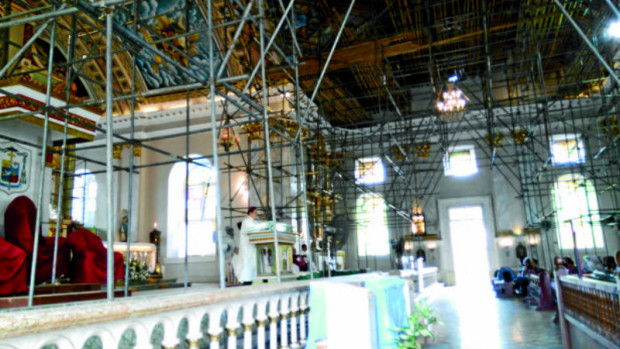
Bishop Leonardo Medroso exhorts Boholanos to remain strong, from under the repair scaffolding in St. Joseph the Worker Cathedral. —LEO UDTOHAN
TAGBILARAN CITY, Bohol —At exactly 8:12 a.m. on Saturday, bells rang, ambulances and police cars blared their sirens, and cars honked their horns for 33 seconds to remember the magnitude-7.2 earthquake that brought this province to its knees three years ago.
A minute of silence for the more than 200 people who perished in the earthquake was observed at St. Joseph the Worker Cathedral in this capital city before the Mass officiated by Tagbilaran Bishop Leonardo Medroso of the Diocese of Tagbilaran.
In his homily, Medroso said that while the people of Bohol don’t want a similar tragedy to happen, “we thank the Lord for the opportunity to experience an earthquake” because it showed the resiliency of the people.
“The value of life can be discovered only by a people who know how to struggle,” said the bishop. “The earthquake has given us the chance to struggle and have courage.”
For 33 seconds on Oct. 15, 2013, the earthquake shook Bohol, destroying houses, roads, bridges, government infrastructure and centuries-old churches.
It was the strongest earthquake to hit the province known for its old churches, pristine beaches, Chocolate Hills and its cultural heritage.
But the earthquake also showed the resiliency of Boholanos, said Medroso.
After the Mass, Gov. Edgar Chatto said the commemoration was a day of prayer and thanksgiving since the road to recovery was not well paved.
Yet, he said, the recovery program of the provincial government was 95-percent complete. Tourism, agriculture and businesses were back on their feet, he said.
After the Mass, the Bohol Resiliency Congress was held at the Bohol Cultural Center to highlight the recovery efforts by different agencies.
Those who lost loved ones in the quake spent the day visiting the places where their relatives were buried alive.
The Somoro and Empinado families visited Bayong Falls in Sagbayan town where five of their children died when the quake struck as they swam.